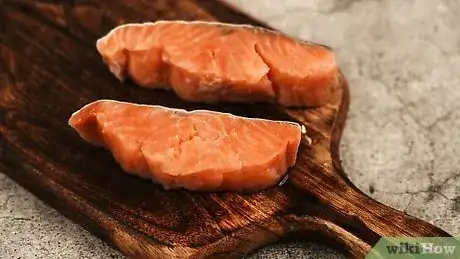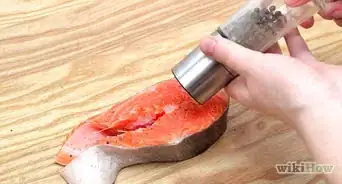This article was co-authored by wikiHow Staff. Our trained team of editors and researchers validate articles for accuracy and comprehensiveness. wikiHow's Content Management Team carefully monitors the work from our editorial staff to ensure that each article is backed by trusted research and meets our high quality standards.
The wikiHow Video Team also followed the article's instructions and verified that they work.
This article has been viewed 94,428 times.
Learn more...
Cured salmon, also called gravlax, has a salty, distilled salmon flavor and a silky texture. The process of curing salmon starts by mixing up a cure, which includes salt, a little sugar, spices and sometimes alcohol. The salmon is coated in the cure, then wrapped in plastic and stored in the refrigerator under weights for three days. After you wash off the cure, the salmon is ready to be thinly sliced and used as a topping for bagels or an elegant addition to a salad.
Steps
Getting the Ingredients Ready
-
1Choose a fat, fresh filet. Curing salmon brings out the best in its fishy flavor, and little subtleties like the salmon's fat content and freshness will stand out after the curing process. The fresher and fattier the salmon, the better your gravlax will taste, so choose the highest quality salmon possible.
- Check the salmon's labeling. Look for sustainably-sourced salmon that was not previously frozen. It's easier to find this while salmon is in season during the summer months. Salmon that has been frozen and thawed will not taste as good after curing.
- To make enough for eight servings, get a two-pound salmon filet with the skin still attached. The flesh should be bright orangish-pink and firm. The skin should look bright and shiny, not spotted or damage.
- Buy the salmon the same day you're planning to start the curing process, if possible. Store it in the refrigerator until you're ready to use it.
-
2Choose your alcohol. It's increasingly popular to rub alcohol over the fish before coating it in a cure. Using vodka, bourbon, rye or another alcohol is not traditional when it comes to the lox you'd get in a deli for your bagel, but it can add a lot of depth during the curing process. If you wish to use alcohol, you'll only need a few tablespoons, enough to rub over the entire filet before you coat it in the cure.[1]Advertisement
-
3Mix up a cure. The most basic ingredient of a salmon cure is salt. Salt draws the moisture from the fish's flesh, changing the taste and texture and acting as a natural preservative. Sugar, spices and citrus zest may be added to provide extra flavor. Start with a basic cure the first time you cure salmon, then consider getting creative and adding your favorite spices and alcohol for a different flair the next time around. Use the following ratio of ingredients for one two-pound piece of salmon:
- 1/2 cup kosher salt (not table salt, which can negatively affect the flavor)
- 3 tablespoons white sugar
- 3 tablespoons of the fresh chopped herbs of your choice, like oregano, dill, basil, fennel or a combination
- 1/2 tablespoon white pepper
- Optional: 1 tablespoon (14.8 ml) lemon zest
Applying the Alcohol Rub and Cure
-
1Rinse and dry the salmon. When you're ready to star the curing process, remove the salmon from the refrigerator and rinse it in cool water, then dry it thoroughly with paper towels.[2]
-
2Lay the salmon on several sheets of plastic wrap. The salmon will need to be tightly wrapped in plastic as it cures. Tear off a few large sheets of plastic wrap and place them on a baking sheet. Lay the salmon fillet skin-side down in the center of the plastic.
-
3Check the salmon for pin bones. Gently press into the flesh of the filet with your fingertips to feel for tiny pin bones. They're usually located near the center of the filet. It's important to remove these before curing the salmon, since they'll interfere when it comes time to slice it up. When you come upon a bone, use a needle-nosed plier to pry it from the flesh, taking care not to damage the filet too much as you do so. Discard the bones when you're finished.
-
4Dress the salmon filet. Time to apply the alcohol and cure mixture to the salmon to begin the curing process. Use enough to cover the filet on both sides. Err on the side of using too much instead of too little, since you can always rinse off the excess flavoring later.
- Rub the salmon with alcohol. Use a tablespoon or two of the alcohol you chose to cover the salmon on both sides. No need to rub it in with pressure; instead, just smooth it over the surface.
- Apply the cure. Use a spoon to sprinkle a good coating of the cure mix over the entire filet. Flip it over and put more on the other side.
Curing the Salmon
-
1Wrap the salmon tightly. Lift the sides of the plastic wrap and wrap up the salmon so that it's tightly covered with no air holes. You may want to get another piece of plastic wrap to make sure the wrapping is secure.
-
2Weight the salmon. Place a second baking sheet over the first one. Nest it in so it's sitting directly on top of the salmon. If you don't have a sheet that fits perfectly, find another flat-surfaced pan or dish to do the job. Put a heavy bowl, a brick, or heavy canned goods on top of the entire contraption. This will compress the cure ingredients into the salmon, creating the right conditions for it to cure.
-
3Refrigerate the salmon for 72 hours. During this time, do nothing to the salmon except wait patiently while it cures. Most chefs recommend three days of refrigeration, though some recipes specify curing for two. It's a matter of taste, so if you prefer salmon that's less salty, go for two instead of three.
-
4Unwrap and rinse the fish. Remove it from the refrigerator and take off the plastic wrap. Rinse the fish under cool running water, washing away the salt and other cure ingredients. If you skip this step, the fish will taste too salty.
-
5Slice the salmon. Use a very sharp knife to cut thin horizontal slices from along the top of the salmon (rather than slicing it vertically as you would a steak). Gravlax has a strong flavor, so thinner slices are more palatable. The salmon is now ready to enjoy.
- Taste the salmon for flavor. If you find it too salty, give in an extra rinse before continuing to slice it.
- The classic way to serve gravlax is with a fresh bagel, cream cheese, sliced red onion and capers. It also makes a great topping for salads, pizzas, crostini, pasta and more.
Community Q&A
-
QuestionDoes the fish have to be previously frozen for the cure?
 Community AnswerNo. Generally, fresh fish will taste better than fish that has spent as much of it's life frozen as it spent in the water. The fresher, the better.
Community AnswerNo. Generally, fresh fish will taste better than fish that has spent as much of it's life frozen as it spent in the water. The fresher, the better. -
QuestionDo you need to use alcohol? I am a Muslim and cannot have alcohol.
 Community AnswerNo, the alcohol is optional. The cure works equally fine with just salt, sugar and whatever herbs you would like to add. You could also use non-alcoholic sparkling grape varieties as an experiment, or use a juice you think might blend well.
Community AnswerNo, the alcohol is optional. The cure works equally fine with just salt, sugar and whatever herbs you would like to add. You could also use non-alcoholic sparkling grape varieties as an experiment, or use a juice you think might blend well. -
QuestionDo I have to use alcohol to cure salmon?
 Community AnswerNo, you can salt cure salmon without alcohol.
Community AnswerNo, you can salt cure salmon without alcohol.
Things You'll Need
- 2 pounds Salmon Fillet
- 1/2 cup Kosher salt
- 2 tablespoons white sugar
- 2 tablespoons alcohol
- 2 tablespoons fresh herbs
- Paper towels
- Plastic wrap
- Baking dish
- Flat dish
- Brick
References
About This Article
To make cured salmon, also known as gravlax, start by selecting the highest quality salmon to ensure it has the best flavor. Look for sustainably-sourced fish that has bright, shiny skin and firm, orangish-pink flesh. Then, prepare your cure by mixing salt, sugar, pepper, and the herbs of your choice. Once you've made the cure, rinse your salmon and lay it on a piece of plastic wrap before rubbing the cure into both sides of the fish. Wrap it tightly, then place it in the refrigerator to cure for at least 3 days. If you want more tips, like how to eat cured salmon, read on!
























































